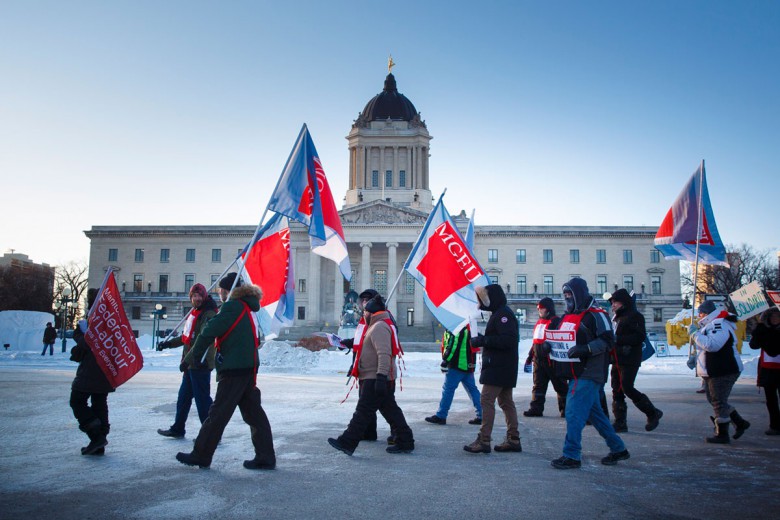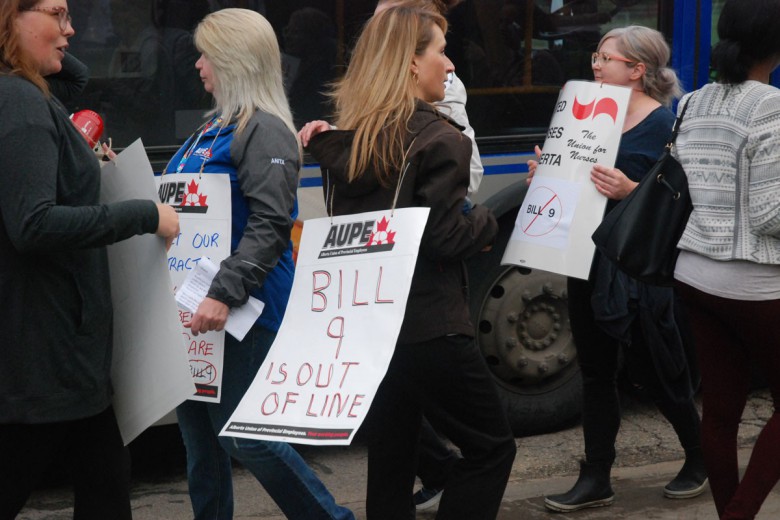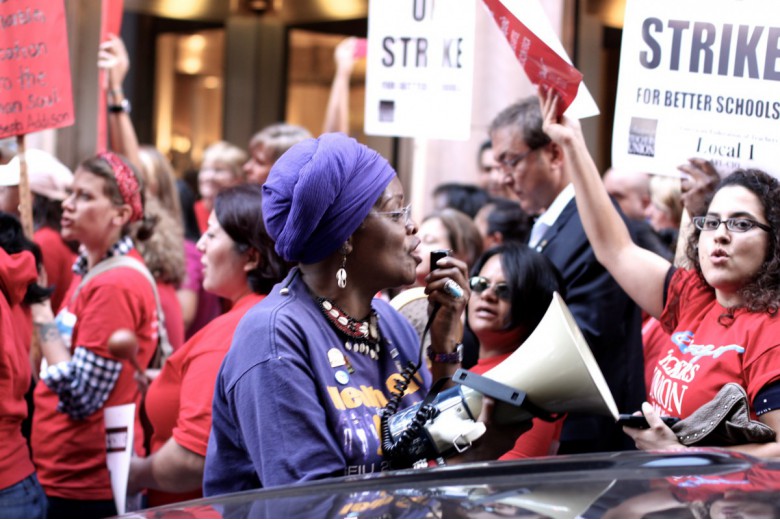Mohamed Yusuf left his home in Ottawa’s Heron Gate community in October 2018, following about four months of organizing with the tenant coalition resisting an eviction order issued by their landlord, Timbercreek Asset Management Inc.
In the end, Yusuf and his neighbours – largely racialized, immigrant, and low-income families – were forced to leave their homes, and the 150 low-rise townhouses in the city’s south end were demolished. Over 500 people were evicted. Timbercreek’s new plan for the area includes around 5,500 units with 20 per cent earmarked as affordable housing. Yusuf calls the Heron Gate evictions a step “to systematically remove those immigrants from the area and bring some middle-class families in there.”
Yusuf’s eviction wasn’t just an example of gentrification; it was part of a larger pattern of financializing housing. Timbercreek is one of many financial actors – including asset managers, private equity firms, and real estate investment trusts (or REITs) – that make up the global financialized housing system.
In this system, housing is an investment commodity, like gold or oil. It’s an abstract bottom line, rather than the tangible and essential place where people live. According to the United Nations, adequate housing is a human right. It’s intrinsically linked to the right to life and absolutely necessary for people to live in safety and dignity.
But treating housing like a commodity is making it harder for people to access that right. It drives up the price of rent in cities across the globe, making shelter less accessible to those who need it.
In this system, housing is an investment commodity, like gold or oil. It’s an abstract bottom line, rather than the tangible and essential place where people live.
And while asset managers like Timbercreek are technically landlords, they are also profit-driven financial institutions. In fact, Timbercreek is one of nine financial institutions in the list of the top 10 biggest landlords in Canada. Their job is to manage the investments of their clients by increasing the value of those investments and mitigating any risk to their value.
“Even if you have an individual property manager or whoever’s in that role, who is sympathetic and willing to work with tenants and build strong relationships, at the end of the day there’s that duty to the shareholder to maximize the value,” explains lawyer Caryma Sa’d, who works with tenants and landlords in Toronto, in an interview with Briarpatch.
“If you have high turnover among your tenants, you’re doing well because you’re not really entrenching any form of rent control. You get the benefit of vacancy decontrol and it’s just a perpetuating cycle,” she continues. Vacancy decontrol, which exists in Ontario, allows landlords to increase the price of rent between tenants.
As a result, Sa’d has observed a pattern of bigger landlords focusing more on renting units than maintaining them.
“Because it’s always like it’s always pushing up, right?” says Sa’d. “You’re not really seeing the unit rent for less. Very rarely will that happen. And so if people just keep switching units, every move bumps the average rent up and affects the market overall. And then especially where there’s a lack of supply, that also serves to increase the price.”
For landlords and real estate investors, tenants regularly moving out of apartments is more profitable than having a tenant remain in an apartment long term. As a result, Sa’d has observed a pattern of bigger landlords focusing more on renting units than maintaining them.
“One thing that I’ve seen is they’ll do a lot of cosmetic changes and work on balconies and the lobby and planting gardens outside and meanwhile, there might not be water pressure,” she observes. “But as they’re bringing in new people to come view, it looks nice, and then the people who are actually living there get fed up and leave, and then their units are worth more because there are these renovations. But it’s not actually designed for people to live in, it’s designed to be a constant turnover.”
From this perspective, investing in real estate doesn’t seem lucrative or at all logical – it just looks like a vicious cycle with few winners.
But if that drive to increase real estate investors’ return on investment is part of what’s making housing unaffordable for most everyone save the highest paid among us, then the common perception of real estate as a safe, desirable investment opportunity for the average person no longer holds. The financialization of housing means that while your real estate investments – should you be fortunate enough to have them – are increasing in value, you’re also spending more of your income on rent or mortgage payments. Apartments are harder to come by, and they’re exorbitantly priced and poorly maintained when they are available. In cases like Heron Gate, you get evicted. Or, worse, you end up homeless. From this perspective, investing in real estate doesn’t seem lucrative or at all logical – it just looks like a vicious cycle with few winners.
I know what you’re thinking: this cycle breaks down as soon as you apply a basic class analysis. Low-income families like Yusuf’s former neighbours in Heron Gate are not the people investing millions of dollars in real estate investment trusts. The people who suffer the consequences of financialized housing are not the same people who are profiting from it.
As Yusuf says, “the smaller fishes are suffering, right? So we have to look into the big picture.”
Pension capitalism
When you take a step back, you can see there is a tiny thread that holds this cycle together: pensions. Workers pay out a small percentage of every paycheque into their pension, and pension funds invest that money with the goal of increasing the funds available for those workers when they retire. And, you guessed it, many pension funds are invested in real estate. Pension funds are one of the biggest financial actors participating in and perpetuating the system of financialized housing.
For example, the Alberta Teachers’ Retirement Fund Board lists real estate company Minto Properties as an investment partner on their website (though when Briarpatch asked about the value of that investment, a spokesperson explained over the phone that details of individual investments are not shared with the public). In 2018, 200 residents of a building in Toronto’s Flemingdon Park neighbourhood went on a rent strike after Minto tried to hike their rent by nearly 5 per cent (the provincial guideline for rent increases in Ontario is 1.8 per cent).
The Manitoba Teachers’ Retirement Allowances Fund (TRAF) confirmed to Briarpatch that they have US$25 million invested in Greystar Real Estate Partners. Greystar was the developer involved in a 2016 case that saw over 600 tenants evicted from rent-controlled apartments in San Jose, California, to make way for pricier new units.
The Ontario Teachers’ Pension Plan wholly owns Cadillac Fairview’s real estate portfolio and, according to their 2019 annual report, the value of their real estate investments is $28.7 billion.
Global real estate company Ivanhoé Cambridge is owned by Quebec investor Caisse de dépôt et placement du Québec (CDPQ), which manages funds for the Québec Pension Plan, the Retirement Plans Sinking Fund, and Government and Public Employees Retirement Plan, to name a few. Ivanhoé jointly owns an 11,000-unit complex in New York City with notoriously unscrupulous international private equity firm, Blackstone. Last August it was reported that 20 to 50 rent-controlled units in the complex were going to be kept empty and all renovations paused following rent law changes that protect tenants and prevent landlords from raising rents through renovations.
The Manitoba Teachers’ Retirement Allowances Fund is also a shareholder in Mustang Equities Inc., which is a holding of Timbercreek. That means teachers in Manitoba were invested in the corporate landlord that evicted hundreds from Heron Gate in 2018.
On the whole, Canadian pensions have enormous economic influence, with the power to shape entire financial markets. The Ontario Municipal Employees Retirement System alone has $17.5 billion invested in real estate as of 2019, according to their annual report. The Ontario Teachers’ Pension Plan wholly owns Cadillac Fairview’s real estate portfolio and, according to their 2019 annual report, the value of their real estate investments is $28.7 billion.
That’s just in Canada. The Canada Pension Plan is one of the top 20 asset owners in the world, with net assets totalling $420.4 billion. As of 2019, its total investment in real estate (exclusively commercial, rather than residential) was $46.1 billion.
Housing affordability in Canada
While Canadian workers put their faith and their funds in their future pensions, REITs, asset managers and other real estate investors are working with Canadian pension funds to make housing less affordable to working-class people now.
In Unaccommodating, a July 2019 report published by the Canadian Centre for Policy Alternatives (CCPA), author and economist David Macdonald explains that in order to afford the rent of a two-bedroom apartment, Canadians need to be making on average at least $20 per hour working full-time. In Calgary and Ottawa, that number is $26. In Vancouver it’s $35.
Provincial minimum wages don’t even come close. Minimum-wage earners can rent a two-bedroom apartment without spending more than a third of their income in only 3 per cent of the 795 Canadian neighbourhoods studied in the report.
"We decided that we’re going to build more affordable housing and additional apartment buildings, and we put the incentives in place to make that happen and, you know, that was that, largely.”
“We’ve essentially built no purpose-built rental, certainly no affordable housing rental, since the early 1990s,” Macdonald tells Briarpatch in an interview. But he’s not arguing that we simply need to increase housing supply to lower demand; he’s also arguing in favour of stronger government policy incentivizing the construction of affordable housing.
“It just shows you how little of the [affordable] apartment stock that was built in the ’70s and ’80s had to do with the ‘market’ and how much of it was just due to policy decisions. We decided that we’re going to build more affordable housing and additional apartment buildings, and we put the incentives in place to make that happen and, you know, that was that, largely.”
Some of these incentives included federal programs like the Assisted Rental Program (the ARP ran from 1974 to 1978), Multiple Unit Residential Building Program (MURB, from 1974 to 1979 and 1980 to 1981), and the Canada Rental Supply Plan (CRSP, from 1981 to 1983). They included grants and interest-free loans to private landlords to “bridge the gap between market rents and economic rents” as well as tax breaks for developers of affordable rental housing units, according to Tom Carter in Housing Policy Debate. In Still Renovating: A History of Canadian Social Housing Policy, author Greg Suttor writes that grants and loans from the ARP and CRSP totalled $1.2 billion and tax incentives in the MURB program cost $2.4 billion in tax expenditures.
But these types of programs were eliminated under the economic reforms of former Conservative prime minister Brian Mulroney in the 1990s, and without those government incentives, developers switched to what was more lucrative: the construction of condos.
"You see your neighbour doing it, you know, so you think ‘oh geez, I can do this too. I mean, any moron can make money in real estate.’”
The key difference between apartments and condos is that apartments are for people to live in, while condos often are not. “You buy a condo before it’s even built,” says Macdonald. “You take the year to build it, you don’t even ever take possession of it. You never move into it. You just sell it at a massive profit a year later. You see your neighbour doing it, you know, so you think ‘oh geez, I can do this too. I mean, any moron can make money in real estate.’”
He says it’s easier and more profitable to divide up an apartment building and sell off individual units (which is actually what makes a condominium a condominium) than it is to sell off an entire apartment building to someone who wants to run it as a landlord.
Pension funds are also in the condo game. Vancouver-based developer Concert Properties builds both rental properties and condominiums, and it is wholly owned by Canadian pension plans. They list 19 Canadian pensions as shareholders on their website, including the United Food & Commercial Workers (UFCW) Union Pension Plan, Teamsters Canadian Pension Plan, and British Columbia Labourers’ Pension Plan.
That means that in Canada’s most expensive cities, there are blocks of empty buildings that could be homes for those who need shelter but are instead 20-storey paycheques for real estate investors – including pension funds.
A human rights approach
Leilani Farha’s solution to the housing crisis in Canada builds – excuse the pun – on Macdonald’s: construct more affordable housing, but regulate the system that allows financiers to exploit that housing for profit. Without regulation, “if you just build more housing, you’re just building more units that might be available for multinational corporations to purchase,” she explains.
In April, Farha completed a six-year term as the United Nations Special Rapporteur on the Right to Adequate Housing. She is the foremost expert on the right to housing internationally. Her message as rapporteur was that governments at all levels should implement the right to housing in legislation.
The right to adequate housing is articulated in the Universal Declaration of Human Rights and the International Covenant on Economic, Social and Cultural Rights. Canada is a signatory to the Declaration, as well as a state party to the Covenant. Under international human rights law, Canada is required to realize the right to housing.
"This is not about doing good acts. And this is not about being progressive or left wing. This is about international legal obligations that have to be enforced and have to be realized.”
“It’s not just, ‘oh, we need good policies,’” Farha tells Briarpatch. “Then we’re left with the benevolence of the government or the political stripes of the current government. This is not about doing good acts. And this is not about being progressive or left wing. This is about international legal obligations that have to be enforced and have to be realized.”
In an alternate timeline, a human rights approach could have protected working-class people in Canada from the austerity measures of the ’90s. What’s needed now are lasting measures to protect our communities, our cities, and our workers.
Farha recommends regulations that create a “hostile environment for investors.” This could mean freezes on rent increases, or higher taxes on real estate investment income.
“These actions I’m describing are compliant or consistent with a human rights approach,” says Farha, “because what they do is they push back against the paradigm of housing as a commodity from which huge profits can be made. And they restore a notion of housing as a human right, a social good, you know, having social value.”
In Canada, steps are being taken toward a human rights future for housing. In 2019, the federal government passed the National Housing Strategy Act (NHSA). The NHSA makes Canada one of a few countries to have the right to housing enshrined in national legislation. While Macdonald estimates that at least 30,000 to 50,000 new units would need to be added to the rental market in one year to bring prices down to a rate that’s affordable for low-income earners, the strategy promises 100,000 new units over 10 years.
Harnessing the (people) power of Canadian pensions
This past February, the NDP introduced Bill C-231, which would amend the Canada Pension Plan Investment Board Act. A private members’ bill, it had its first reading on February 26, and if it becomes law, it would prevent the CPP Investment Board from investing or holding an investment in an entity whose work is contrary to human, labour, or environmental rights. While an important first step in regulating pension investments broadly, this bill addresses the CPP, which is currently only invested in commercial and not residential real estate – it won’t impact private pensions.
What Bill C-231 does offer – apart from an incredible precedent – is a glimpse into the way pensions can be used to further a progressive agenda, particularly one that benefits workers.
For many years, divestment campaigns have been used to successfully force organizations – like universities, foundations, churches, and pension funds – to drop their investments in the worst companies destroying our collective future. Last year, the Canada Pension Plan Investment Board quietly divested $10 million from two private prison operators that had detained thousands of migrants along the U.S.-Mexico border. The victory came after SumOfUs and LeadNow collected more than 55,000 signatures on petitions, and activists attended public CPPIB meetings to call for divestment.
Given the amount of money they control, if Canada’s biggest pension funds chose to invest in projects that promised safety and dignity for the working class, that choice could transform society for the better.
Last March, Heron Gate tenant rights organizers attempted a similar strategy, sending a message to Manitoba public school teachers: “Please stop investing in the destruction of our neighbourhood.” They were asking teachers to pressure their pension fund to divest from Mustang Equities. The organizers did not reach out to TRAF directly, though, and TRAF did not respond to the campaign, a representative of the Heron Gate Tenant Coalition told me via a private message on Twitter.
But divestment from projects that contravene human rights is one piece of the puzzle. Given the amount of money they control, if Canada’s biggest pension funds chose to invest in projects that promised safety and dignity for the working class, that choice could transform society for the better.
We cannot let workers be exploited by the institutions that promise to protect them. This isn’t just about those who pay into private pension funds (which, in Canada, is only 37 per cent of workers). There are people in the gig economy, undocumented folks, people doing full-time unpaid domestic labour, and sex workers who are all being evicted from their homes and priced out of cities, too – and without the promise of a pension’s protection, to boot.
This is about solidarity with the working class as a whole.







